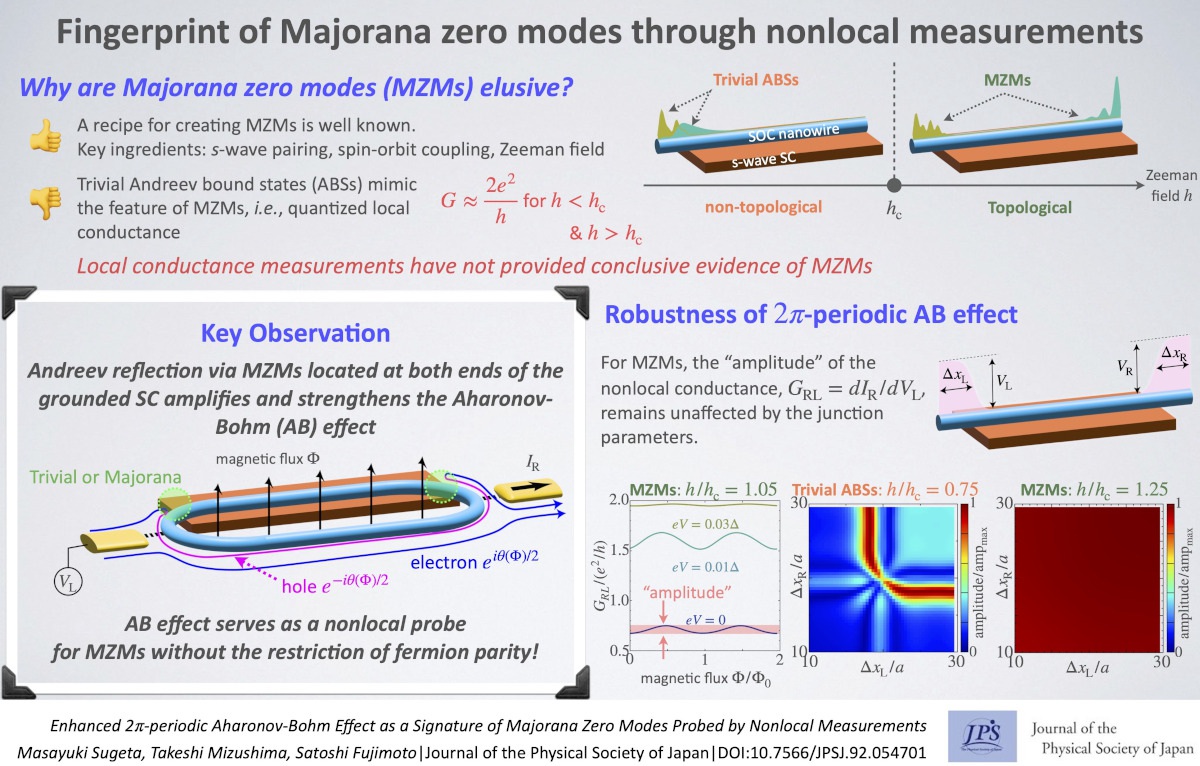Fingerprint of Majorana Zero Modes through Nonlocal Measurements
© The Physical Society of Japan
This article is on
Enhanced 2π-periodic Aharonov–Bohm Effect as a Signature of Majorana Zero Modes Probed by Nonlocal Measurements
(JPSJ Editors' Choice)
J. Phys. Soc. Jpn. 92, 054701 (2023).
The enhancement and robustness of the 2π periodic Aharonov-Bohm effect can serve as a nonlocal probe of Majorana zero modes in topological superconductors that are not restricted by fermion parity.

Electrons on the surface of topological superconductors behave as if they are split into two separate locations, a phenomenon known as fractionalization. This feature distinguishes Majorana fermions, specifically Majorana zero modes (MZMs), which have been studied for potential application in topological quantum computations. However, conventional local measurements, such as the quantization of local conductance, have failed to detect them because such characteristics are smeared by the trivial Andreev-bound states arising from inhomogeneous potentials around junctions. The nonlocality of MZMs, which arises from fractionalization, necessitates a new detection method. The two bound states at both ends of a one-dimensional topological superconductor retain nonlocal correlations, indicating their origin from a single electron. As this remarkable property is absent in trivial bound states, its detection would provide conclusive evidence of MZMs. However, this requires a floating superconductor that preserves the parity of electrons, which hinders experimental realization.
We highlight the significance of the nonlocality of MZMs (electron fractionalization) in considerably amplifying and strengthening the Aharonov-Bohm (AB) effect, even in grounded superconductors where the parity of electrons is not conserved.
We examined a loop-shaped junction system consisting of a one-dimensional topological superconductor and metal lead wire, and proposed nonlocal conductance measurements to observe the AB effect caused by a magnetic flux penetrating the loop. In general, Andreev reflection occurs at the interface between a superconductor and metal. When electrons in a metal undergo Andreev reflection repeatedly at both ends of the superconducting wire, the nonlocal conductance oscillates with 2π periodicity as a function of the magnetic flux Φ. Multiple Andreev reflections occur at two different junctions when the bound state energies at the two interfaces are close to each other. However, in the topological phase, the energies of the MZMs at both interfaces match closely. This reflects the aforementioned fractionalization phenomenon, leading to a robust AB effect. Our calculations indicated that in the non-topological phase, the AB effect through trivial bound states was considerably influenced by the parameters of the inhomogeneous potentials at the two interfaces and only occurred in a very narrow range of parameters. However, in the topological phase, the AB effect caused by MZMs was robust in all parameter regions. Unlike other nonlocal correlations such as Majorana-mediated teleportation, this phenomenon usually occurs without the restriction of fermion parity. The stability of the AB effect against interface details is crucial for detecting MZMs. MZMs and trivial bound states are more distinguishable in nonlocal correlation measurements than in local conductance measurements. Our study proposes that nonlocal correlation measurements may lead to new developments in the quest for MZMs in topological superconductors.
(written by T .Mizushima on behalf of all authors.)
Enhanced 2π-periodic Aharonov–Bohm Effect as a Signature of Majorana Zero Modes Probed by Nonlocal Measurements
(JPSJ Editors' Choice)
J. Phys. Soc. Jpn. 92, 054701 (2023).
Share this topic
Fields
Related Articles
-
Microscopic Exploration of Electronic States in Nickelate Superconductors
Magnetic properties in condensed matter
Superconductivity
2024-5-31
The multilayered nickelates, La3Ni2O7 and La4Ni3O10 , were investigated using nuclear magnetic resonance (NMR) at ambient pressure. Metallic electronic states under the density wave order were observed microscopically for both compounds.
-
Single-Crystal Growth of a Cuprate Superconductor with the Highest Critical Temperature
Superconductivity
2024-5-20
Millimeter-sized single crystals of a trilayer cuprate superconductor (Hg,Re)Ba2Ca2Cu3O8+δ that exhibits the highest superconducting transition temperature under ambient pressure, were grown reproducibly and safely.
-
Cooking in Salt for Ultra-Clean Superconductor UTe2
Superconductivity
2024-4-30
A new crystal growth technique, the molten salt flux liquid transport method, was developed to produce high-quality single crystals of spin-triplet superconductor UTe2. This method is promising for exploring the exotic superconductivity of other materials.
-
Exploring Electronic States in BEDT-TTF Organic Superconductors
Superconductivity
Electronic transport in condensed matter
Magnetic properties in condensed matter
2024-4-24
This review, published in the Journal of the Physical Society of Japan, provides a comprehensive summary of the electronic states observed in BEDT-TTF type organic superconductors, including metal-insulator transitions, Mottness transitions, non-Fermi liquids, quantum spin liquids, and Bose-Einstein condensation.
-
A New Superconductor Family with Various Magnetic Elements
Superconductivity
Cross-disciplinary physics and related areas of science and technology
Electron states in condensed matter
2023-10-27
A new superconductor family, Sc6MTe2, has been discovered, comprising seven variations with magnetic elements labeled as M. Notably, only a few known superconductor families exist that involve various magnetic elements.
